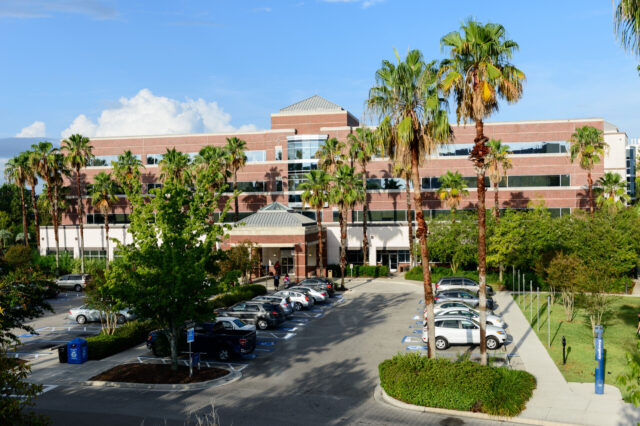Lymphangioleiomyomatosis (LAM)
What is lymphangioleiomyomatosis?
Lymphangioleiomyomatosis, or LAM, is a rare lung disease that causes small cysts to grow in the lungs, mostly affecting women.. In the lungs, these cysts can obstruct the airways, damage lung tissue and result in lower oxygen levels in the blood and can lead to respiratory failure. This can result in difficulty breathing, lung collapse, fluid accumulation around the lungs, and fatigue.
Although there is no cure for LAM, an early diagnosis and treatment can help extend life and increase quality of life.
The physicians and surgeons at the Rare Lung Disease Clinic at University of Florida Health provide patients with LAM a comprehensive, tailored treatment and disease management.
What causes LAM?
LAM can develop on its own without any cause, known as sporadic lymphangioleiomyomatosis, or can occur in the setting of a genetic disorder called tuberous sclerosis complex, or TSC, which is a rare genetic disorder that causes tumors to grow in the brain, kidney, heart, eyes, lungs and other areas. Women with TSC are at the greatest risk for LAM, affecting roughly three out of 10 women.
In both causes, abnormal cells called LAM cells make their way to the lungs. Cysts are then formed throughout the lungs, resulting in symptoms that can make it difficult to breathe.
Symptoms
Some LAM patients may not have any symptoms and the disease is found incidentally.
In other cases, a symptom may develop slowly and get worse as the disease progresses. It may start as increased tiredness and shortness of breath.
LAM patients can develop lesions on the kidneys known as angiomyolipoma.
Other LAM symptoms include:
- Lightheadedness
- Sudden collapsed lung (pneumothorax)
- Pain in the abdomen
- Chest pain
- Cough
- Fatigue
Diagnosis and tests
To diagnose LAM, a health care provider will perform a physical exam and ask about your symptoms, along with checking your medical records. The exam may find:
- Abnormal breathing sounds
- Skin lesions that may occur in the setting of tuberous sclerosis
In the early stages of the disease, the exam may be normal or almost normal. Symptoms can be similar to those of more common lung conditions, such as asthma, so it can be hard for health care providers to diagnose. These other conditions must be ruled out.
You may need the following tests:
- Blood oxygen level tests
- Blood VEGF-D level
- Lung function test
- Chest X-ray
- CT scan of the chest
- Echocardiogram
- Genetic test
- Lung biopsy
Management and treatment
There is no cure for LAM. The goal of treatment focuses on preserving lung function, preventing complications and improving symptoms. You and your physician will work together to create a treatment plan tailored to your needs.
Sirolimus and everolimus are the only medical treatments for LAM. These medications may help stabilize lung function. An inhaler may be prescribed to help with breathing. Your provider will decide which medicine is best for you.
Other treatments may include:
- Treatment of lung collapse or lung damage
- Oxygen therapy at home
- Treatment of kidney lesions
- Lung transplant, in advanced cases
Outlook and prognosis
LAM can get worse over time, and treatment may change depending on what's working best. You will work with a pulmonologist (a health care provider who specializes in the lungs) to determine the best way to monitor your condition. They will test your lung function periodically.
The progression can vary from patient to patient and depends on many factors, including:
- Type of LAM
- Age
- Response to treatment
Many people with LAM can live decades after their diagnosis before needing a lung transplant. However, because LAM cells don't start in your lungs, cysts can come back, even after transplantation.
Other tips to follow:
- Avoid heavy lifting
- Avoid smoking
- Discuss with your LAM specialist before considering getting pregnant
- Get a yearly flu vaccine, as well as other vaccines such as the pneumonia vaccine and the COVID-19 vaccine
How does LAM progress?
As LAM cells invade your lung tissue, there may be a risk of developing pleural effusions (leaking of fluid into your chest cavity), pneumothorax, an enlarged lymph node or angiomyolipomas (benign growths on your kidneys).
When to contact a medical professional
Contact your provider if you develop:
- Sudden or worsening shortness of breath
- Chest pain
- Coughing up blood
Patient information
For more information, visit www.thelamfoundation.org to learn more and view the patient education sheet.
Related conditions and treatments
Our experts
-
Ali Ataya, MDCritical Care Medicine Specialist, Pulmonologist (Lung Specialist)

Our locations
-
Specialty Care Practice UF Health Pulmonary – Medical Specialties – Medical Plaza


